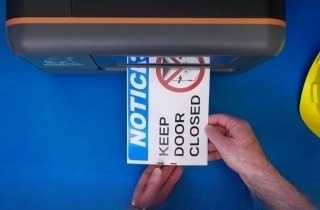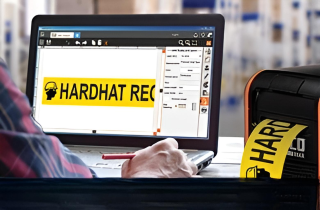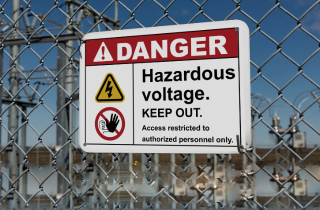5 Ways to Make Workplace Safety Signs Stand Out

How Safety Signage Improves Hazard Communication and Employee Awareness
Workplace safety signs play a key role in visual hazard communication. They guide behavior, support emergency response, and help ensure that safety messages are accessible across shifts, languages, and learning styles.
Even when formal training has been completed, employees need ongoing visual reinforcement to stay alert to risks. From communicating required PPE, restricted areas, and emergency exits, signs can bridge that gap.
Visual management signage also helps streamline operations. When workers can easily locate tools, identify pipe contents, or understand equipment hazards, they work more efficiently and with fewer errors. Clear signage empowers employees to make safe decisions in real time.
Why OSHA Safety Signs are Essential for Regulatory Compliance
Safety signage is more than a visual aid. It's a compliance requirement. The Occupational Safety and Health Administration (OSHA) mandates that employers use signs, tags, and labels to alert workers to potential hazards. These visual cues must comply with the ANSI Z535 standard, which outlines formatting, signal words, color codes, and symbol use.
There are five primary types of OSHA safety signs:
- Danger: for immediate, life-threatening hazards
- Warning: for serious but non-lethal risks
- Caution: for moderate hazards requiring attention
- Notice: for non-hazard instructions or information
- Safety Instruction: for general safety procedures
Signs that fail to meet these criteria, or are missing entirely, can result in citations and create liability issues. In one notable case, a construction site fatality led to OSHA citations after contractors failed to post caution signs in a known hazard zone. Compliance with signage requirements is more than a formality. It’s a frontline safety measure.
Techniques for Making Safety Signs More Visible to Prevent Workplace Accidents
Workplace safety signs must be consistent, durable, and instantly recognizable. Below are five ways to enhance visibility and impact:
1. Use Visual Design to Increase Clarity
Strong signage design starts with readability. Workers need to quickly interpret what a sign is saying, even from a distance or under time pressure. Effective design includes bold headings (like “DANGER” or “CAUTION”), large fonts, and uncluttered layouts. Icons or symbols enhance clarity, especially for multilingual teams.
Visual hierarchy matters. Use larger font sizes for the most urgent messages and consistent formatting across all signage. Incorporate ANSI-compliant colors, and where appropriate, include site-specific details such as equipment IDs or directional arrows.
Advanced labeling software simplifies this process. With preloaded templates and customization options, safety teams can design standardized, compliant signs that reflect the facility’s specific needs.
2. Ensure Consistent Use of Signal Colors and Symbols
Once safety signage is designed with OSHA and ANSI standards in mind, consistency becomes the next critical factor. A facility that uses standardized color schemes and pictograms builds familiarity, and familiarity saves time in emergencies.
Inconsistent application, like switching between yellow and orange for cautionary signs or mixing symbol styles, creates confusion. Workers may hesitate or misinterpret a message, especially under stress. That's why it's important to develop a visual communication standard across all departments or facilities.
 Use the same iconography, color formatting, and terminology throughout your signage system. This includes:
Use the same iconography, color formatting, and terminology throughout your signage system. This includes:
-
Consistent use of danger, warning, and caution headers
-
Uniform placement of signs in similar work zones
-
Clear visual grouping of related signs (e.g., PPE requirements, emergency exits)
For multi-site operations, a unified signage standard reduces retraining needs and helps enforce brand-wide safety culture. Using labeling software with preloaded ANSI-compliant templates can help enforce these standards, especially when managing sign creation across multiple teams.
3. Choose Materials Suited to the Environment
Durability is a key factor in making safety signs effective. Paper signs quickly fade, tear, or fall off in industrial settings. Instead, use industrial-grade materials that withstand the conditions in which they’re placed.
For example:
-
High-tack vinyl: ideal for textured or irregular surfaces
-
Premium vinyl: works well in indoor, low-impact areas
-
UV-resistant materials: are essential for outdoor signage
-
Cold storage environments: need labels that perform in freezing temperatures
Consider environmental exposures like moisture, chemicals, sunlight, and abrasion. Choose supplies that won’t degrade over time and compromise the message.
A common oversight is using general-purpose labels in high-demand zones. If a safety sign wears off or becomes unreadable, it could lead to confusion, lost time, or injuries.
4. Reinforce Messages with Floor Signs
Floor signs are often overlooked but can greatly enhance message visibility, especially in high-traffic areas. They are particularly useful for directing foot traffic, identifying forklift paths, or reinforcing PPE requirements at transition points.
Unlike wall-mounted signs, floor signs are directly in workers’ line of sight during movement. They’re ideal for reinforcing rules that are already displayed elsewhere, such as “Stop—Forklift Crossing” or “Hard Hat Area.”
To be effective, floor signs must be made from durable materials that resist peeling, wear, and chemical spills. Floor marking tape can also be used in tandem to create full visual workflows, supporting lean and 5S initiatives.
5. Support Signage with Training
Even the most visible sign loses impact if workers don’t understand its meaning or ignore it due to overexposure. That’s where training and regular signage audits come in.
Train employees not only on what signs say, but on why they’re posted and what action is expected. During onboarding, include a walkthrough of critical signage. Reinforce that knowledge through toolbox talks, safety meetings, and periodic refreshers.
Conduct signage audits as part of job hazard analyses. Look for missing signs, outdated language, or signs that have become dirty or damaged. Ask: Is the message still relevant? Is it being followed? Does it need to be relocated?
When new hazards arise or layouts change, signage should be updated immediately, and not weeks later. Regular review ensures signs continue to do their job.
DuraLabel Custom Labeling Resources
 When it comes to safety signs in the workplace, managers should start with a facility-wide communication assessment. Evaluate each step of a job hazard analysis and identify missing, outdated, or unclear signs. Consistency is especially important in lean systems like 5S, where signage supports sustainment and visual control.
When it comes to safety signs in the workplace, managers should start with a facility-wide communication assessment. Evaluate each step of a job hazard analysis and identify missing, outdated, or unclear signs. Consistency is especially important in lean systems like 5S, where signage supports sustainment and visual control.
To help teams act quickly and professionally, the DuraLabel Kodiak Max Sign and Label System offers a fast, on-site solution. With built-in OSHA/ANSI templates and industrial-grade supplies, Kodiak Max helps facilities stay compliant while eliminating the need for handwritten signs.
DuraLabel’s free OSHA Signs Quick Start Guide provides a practical overview of what compliance looks like in the field. The guide explains OSHA’s formatting rules for signal words like “Danger,” “Warning,” and “Caution,” offers visual examples of compliant signs, and outlines common sign types by application. It also includes material recommendations based on environmental exposure and best practices for optimizing visibility and placement. Download your copy today.
Need help building or updating your safety signage system? Call 1-888-789-7964 to speak with a safety and compliance specialist.Read Next:
OSHA Signs Regulations and Compliance: Everything You Need to Know
Related Resources

How Custom Vinyl Labels Help Facilities Boost Safety and Compliance
Why Are Premium Custom Vinyl Labels Important forWorkplace Safety? Premium custom vinyl labels are gaining ...
Read
Crucial Objectives for Industrial Professionals
Workplaces are adjusting goals and protocols to meet new and changing demands. Here are a few key objectives ...
Read
How to Improve Eyewash Station Safety in Healthcare Workspaces
How to Improve Eyewash Station Safety in Clinical and Lab Settings Our eyes are vulnerable in high-risk ...
Read.png)





